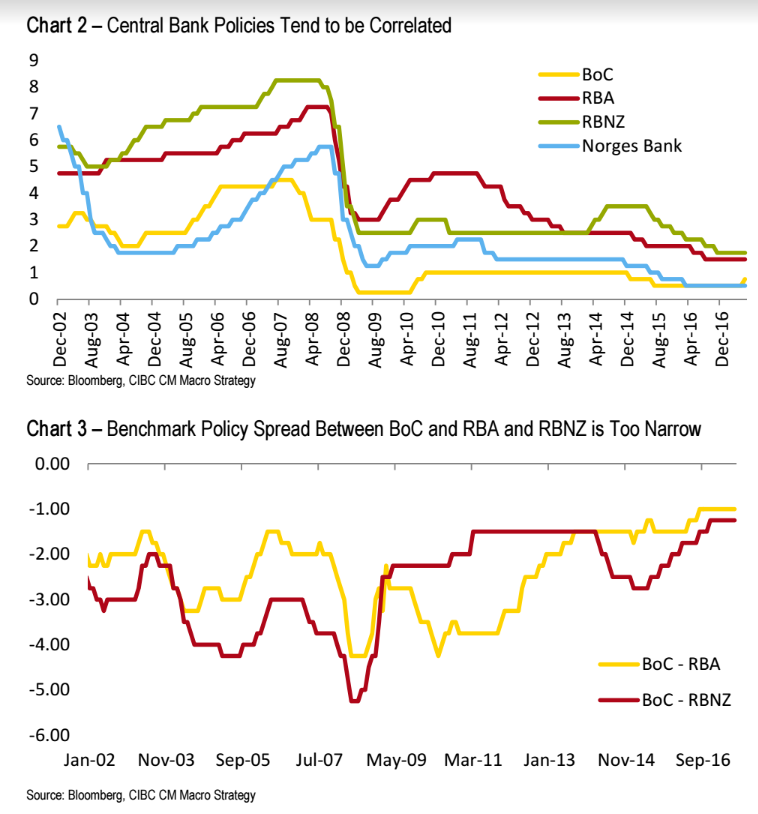Australian and Canadian Dollars to Strengthen Even Further, Regardless of What Commodity Prices Do

The commodity currency block, which includes AUD, CAD, NOK and the NZD, is forecast to turn higher, says analyst Bipan Rai of CIBC Economics.
Recent strength is “here to stay”, adds the analyst, who points to improvements in the domestic economies of these currencies as the main driver.
The Australian and Candian Dollar have both lead the pack and the findings should come as welcome news to those bidding on an extension of recent strength.
This is unusual given that typically we would expect rising commodity prices to push commodity currencies higher. Indeed, a rise in commodity prices would be an added bonus.
“The outperformance of commodity currencies will be driven more so from improving endogenous backdrops rather than a recovery in commodity prices,” confirms Rai.
Central Banks
One major factor for the forecast is a more hawkish central bank policy agenda.
“We expect the RBA, Norges Bank and the RBNZ to begin their shift from neutral to hawkish in the coming months,” said Rai.
The Reserve Bank of Australia (RBA) is expected to be the first to raise interest rates – potentially as early as the August meeting – especially if Q2 inflation, out on July 25, beats expectations.
The Norges Bank policy will likely shadow policy changes at the European Central Bank (ECB), and as such, we may have to wait until the October-December meeting dates for any change.
NZD should also outperform, but with a slight lag.
The Reserve Bank of New Zealand (RBNZ) will probably lag other central banks given the upcoming change in the leadership, along with concerns regarding the real exchange rate, which they want to keep down.
The Bank of Canada (BOC) is expected to undertake a rate hike in October with another likely at the January meeting.
This follows the June rate rise that spawned a strong advance in the Canadian currency.
Get up to 5% more foreign exchange by using a specialist provider. Get closer to the real market rate and avoid the gaping spreads charged by your bank for international payments. Learn more here.
Economic Adjustment Complete
Commodity economies have had to adjust to a ‘new normal’ of lower commodity prices which has weighed on many of them, however, Rai says that period of adjustment has now ended.
The Canadian economy has now fully adjusted to lower average oil prices and the Australian economy to the collapse in mining investment.
New Zealand is slightly different as RBNZ is ignoring better growth data but eventually they should adapt too.
“We expect that the timeline for the rate hike will be brought forward once the real exchange rate has moderated to an appreciable extent,” said CIBC.
Commodity Currency Central Banks Intertwined
Commodities are so cyclical that the policy agendas of the central banks of major commodity trading countries also tend to harmonize.
“Given the degree of dependency on commodity exports, the business cycles in all four economies are leveraged to global demand and tend to trend together,” said Rai.
It is very rare for the central banks to start cycles of tightening/easing on their own.
They rarely decouple for extended periods of time.
The exception being the early 2014 RBNZ rate hike cycle, but since then we’ve seen the “RBNZ roll back those hikes,” anyway, says Rai.
CIBC think the RBA will follow in the BOC’s footsteps.
The inconsistent difference between commodity central bank lending rates which are extremely narrow and well harmonized and yet the wide variation in avowed policy stance between the banks – e.g the BOC now in a hawkish cycle and the RBA still neutral – suggests the RBA will be next to raise interest rates.
“The spread between the BoC’s overnight lending rate and the RBA’s cash target rate is the narrowest in close to 17 years (the same for the spread between the BoC and RBNZ). Given that trend growth is lower in Canada, that doesn’t quite jive over the long-run.
With the BOC having now commenced a rate hike cycle, we expect the RBA to be the next central bank to turn hawkish and for these spreads to return to norms,” said CIBC.

Overall policy Rates are too loose in commodity economies and whilst BOC has taken steps to remedy this, the RBA and RBNZ have not yet, but are expected to soon.
Generally, the four economies are recovering well: their labour markets are firming “aggressively”, and Business sentiment in both Canada and Norway, “have recovered to an appreciable extent.”
“In Australia, the decline in business investment was driven by a heavy drop in new engineering construction and there are early signs that this decline is starting to level off,” said Rai.
There are early signs the Australian decline in engineering construction is levelling off.
However, there are still concerns about wage growth and whether the “Philips curve” linking unemployment to inflation is ‘applicable’ given overhead wage pressures.
Outlook for individual Pairs
USD/CAD rallies are an opportunity to sell, with an expected test of the 1.2460-1.2500 area to come in the near-term.
AUD/USD: recent strength following a break above the 0.7150-0.7756 consolidation range places the measured move target at 0.8350 mark.
“Resistance at the 0.8165/70 area needs to be monitored ahead of then,” however, notes Rai.
NZD/USD: Dips back to the 0.7000-0.7200 range are likely to be supported.
USD/NOK is expected to move lower. It has reached a longer-term target at the 8.00 handle. Rai says: “wait for rallies above the 8.10 mark to reload.”




